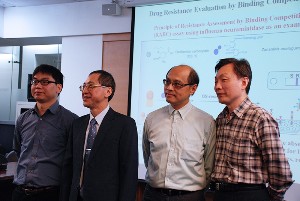 Team Members: Dr. Nung Sen Wang, Dr. Jim-Min Fang, Dr. Meng-Hsin Chen(TaiMed Biologics) and Dr. Jason Mao(TaiMed Biologics).Tamiflu, an orally available drug targeting influenza neuraminidase, has been used widely in clinics for treating influenza virus infections. Over the years of usage, influenza viruses have developed resistance over Tamiflu. A timely judgment of the use of Tamiflu or Zanamivir, another neuraminidase inhibitor with nasal administration, on treating virus-infected patients is important to ensure correct and effective treatment. Once resistant viruses are found, new anti-influenza agents are needed to treat the patients carrying drug-resistant viruses.
Team Members: Dr. Nung Sen Wang, Dr. Jim-Min Fang, Dr. Meng-Hsin Chen(TaiMed Biologics) and Dr. Jason Mao(TaiMed Biologics).Tamiflu, an orally available drug targeting influenza neuraminidase, has been used widely in clinics for treating influenza virus infections. Over the years of usage, influenza viruses have developed resistance over Tamiflu. A timely judgment of the use of Tamiflu or Zanamivir, another neuraminidase inhibitor with nasal administration, on treating virus-infected patients is important to ensure correct and effective treatment. Once resistant viruses are found, new anti-influenza agents are needed to treat the patients carrying drug-resistant viruses.
The scientists from The Genomics Research Center (GRC), Academia Sinica, first developed a simple system to detect Tamiflu susceptibilities of the influenza viruses that show up in clinics. They created a chemical probe to differentiate Tamiflu-resistant viruses. The chemical probe is a zanamivir–biotin (ZB) conjugate that has zanamivir to bind both sensitive and resistant viruses, and has biotin as a reporter to generate signals. In this Resistance Assessment by Binding Competition (RABC) method, the chemical probe competes with oseltamivir carboxylate (the active ingredient of Tamiflu) for binding to the virus. That is, the chemical probe binds Tamiflu-resistant viruses to release signal, but not the Tamiflu-sensitive viruses in the presence of oseltamivir carboxylate.
The GRC group further used this method to examine the pandemic and Taiwan seasonal influenza isolates collected in the years 2005–2009. They found that many 2009-pandamic viruses and all seasonal influenza strains in Taiwan are Tamiflu resistant since late 2008. Unlike the laboratory tests that require sophisticated instruments, the RABC assay can be modified into a quick test and the results are judged by naked-eyes. In combination with the sugar array technologies developed in GRC, the RABC assay is used for simultaneous determination of hemagglutinin subtypes and the Tamiflu susceptibility of influenza viruses.
 The chemical probe (ZB) is constructed by conjugation of zanamivir and biotin to differentiate Tamiflu-sensitive and resistant viruses. When viruses are Tamiflu-sensitive, probe cannot bind to the viruses and thus no signals are generated (top right). However, Tamiflu (OS) cannot replace the binding between the chemical probe and the neuraminidase (NA) of resistant virus, and thus biotin can be detected (bottom right).The GRC group also foresees that the ammunition is running out in the battle with drug-resistant influenza viruses. In 2007 the team discovered Tamiphosphor as a new potent neuraminidase inhibitor against human and avian influenza. The team has continuously worked on improving the efficacy of Tamiphosphor against influenza viruses. By incorporation of guanidine group and monoethyl ester, the new Tamiphosphor derivatives showed enhanced activity against a wide range of Tamiflu-sensitive and Tamiflu-resistant viruses in mice tests. Thorough pharmacokinetics studies in animals indicated that the Tamiphosphor derivatives survive through metabolism. These molecules may be developed with non-oral administration, or made orally available with improvements in formulation. The research results showed promise to develop new anti-influenza agents for practical therapeutic uses.
The chemical probe (ZB) is constructed by conjugation of zanamivir and biotin to differentiate Tamiflu-sensitive and resistant viruses. When viruses are Tamiflu-sensitive, probe cannot bind to the viruses and thus no signals are generated (top right). However, Tamiflu (OS) cannot replace the binding between the chemical probe and the neuraminidase (NA) of resistant virus, and thus biotin can be detected (bottom right).The GRC group also foresees that the ammunition is running out in the battle with drug-resistant influenza viruses. In 2007 the team discovered Tamiphosphor as a new potent neuraminidase inhibitor against human and avian influenza. The team has continuously worked on improving the efficacy of Tamiphosphor against influenza viruses. By incorporation of guanidine group and monoethyl ester, the new Tamiphosphor derivatives showed enhanced activity against a wide range of Tamiflu-sensitive and Tamiflu-resistant viruses in mice tests. Thorough pharmacokinetics studies in animals indicated that the Tamiphosphor derivatives survive through metabolism. These molecules may be developed with non-oral administration, or made orally available with improvements in formulation. The research results showed promise to develop new anti-influenza agents for practical therapeutic uses.
This research project was directed by Dr. Chi-Huey Wong and Dr. Jim-Min Fang, a professor at National Taiwan University with a joint appointment at GRC. In addition to the scientists in GRC, the project involved the efforts from Center of Disease Control in Taiwan, Dr. Oliver Yoa-Pu Hu from National Defense Medical Center in Taiwan, Taimed Biologics in the United States, and Dr. E. Bart Tarbet from Utah State University, the United States of America.
The papers entitled “Chemical probes for drug-resistance assessment by binding competition (RABC): oseltamivir susceptibility evaluation” and “Development of oseltamivir phosphonate congeners as anti-influenza agents” are published in Angewante Chemie (web release on November 13, 2012) and Journal of Medicinal Chemistry (web release on October 20, 2012), respectively.
Article link: